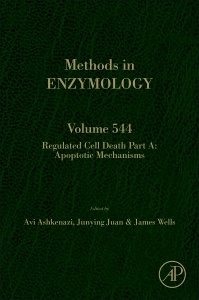Description
Regulated Cell Death Part A
Apoptotic Mechanisms
Methods in Enzymology Series
Coordinators: Ashkenazi Avi, Yuan Junying, Wells Jim
Language: English
Subjects for Regulated Cell Death Part A:
Keywords
Apoptosis; Necroptosis; Autphagy; Caspase; Bcl-2; Death Receptor; RIPK; ATG; C; Elegans; Drosophila; Zebrafish
Publication date: 06-2014
504 p. · 15x22.8 cm · Hardback
504 p. · 15x22.8 cm · Hardback
Description
/li>Contents
/li>Biography
/li>Comment
/li>
Regulated Cell Death Part A & Part B of Methods in Enzymology continues the legacy of this premier serial with quality chapters authored by leaders in the field. This volume covers research methods in apoptosis focusing on the important areas of intrinsic pathway, extrinsic pathway, caspases, cellular assays and post-apoptotic effects and model organisms; as well as topics on necroptosis and screening approaches.
1. Examining the Molecular Mechanism of Bcl-2 Family Proteins at Membranes by Fluorescence Spectroscopy.
2. Photoreactive Stapled Peptides to Identify and Characterize BCL-2 Family Interaction Sites by Mass Spectrometry
3. The Structural Biology of BH3-only proteins
4. How to Analyze Mitochondrial Morphology in Healthy Cells and Apoptotic Cells in Caenorhabditis elegans
5. Apoptosis Initiation Through the Cell-Extrinsic Pathway
6. Using RNAi Screening Technologies to Interrogate the Extrinsic Apoptosis Pathway
7. Caspase Enzymology and Activation Mechanisms
8. Turning ON Caspases with Genetics and Small Molecules
9. A Multi-Pronged Approach for Compiling a Global Map of Allosteric Regulation in the Apoptotic Caspases
10. Measuring Caspase Activity in vivo
11. Single-Molecule Sensing of Caspase Activation in Live Cells via Plasmon Coupling Nanotechnology
12. In vivo Monitoring of Caspase Activation Using a Fluorescence Resonance Energy Transfer-Based Tfluorescent Probe
13. Global Analysis of Cellular Proteolysis by Selective Enzymatic Labeling of Protein N-termini
14. Complementary Methods for the Identification of Substrates of Proteolysis
15. Phospholipid Scrambling on the Plasma Membrane
16. Studying Apoptosis in the Zebrafish
2. Photoreactive Stapled Peptides to Identify and Characterize BCL-2 Family Interaction Sites by Mass Spectrometry
3. The Structural Biology of BH3-only proteins
4. How to Analyze Mitochondrial Morphology in Healthy Cells and Apoptotic Cells in Caenorhabditis elegans
5. Apoptosis Initiation Through the Cell-Extrinsic Pathway
6. Using RNAi Screening Technologies to Interrogate the Extrinsic Apoptosis Pathway
7. Caspase Enzymology and Activation Mechanisms
8. Turning ON Caspases with Genetics and Small Molecules
9. A Multi-Pronged Approach for Compiling a Global Map of Allosteric Regulation in the Apoptotic Caspases
10. Measuring Caspase Activity in vivo
11. Single-Molecule Sensing of Caspase Activation in Live Cells via Plasmon Coupling Nanotechnology
12. In vivo Monitoring of Caspase Activation Using a Fluorescence Resonance Energy Transfer-Based Tfluorescent Probe
13. Global Analysis of Cellular Proteolysis by Selective Enzymatic Labeling of Protein N-termini
14. Complementary Methods for the Identification of Substrates of Proteolysis
15. Phospholipid Scrambling on the Plasma Membrane
16. Studying Apoptosis in the Zebrafish
Dr Avi Ashkenazi received his PhD in Biochemistry in 1986 from the Hebrew University of Jerusalem, Israel. From 1986 to 1989 he trained as a postdoctoral fellow at the University of California, San Francisco, and the biotechnology company, Genentech. As a postdoc, he helped identify the muscarinic acetylcholine receptor gene family and deciphered its interactions with specific G proteins – work that in 1988 earned him and two of his colleagues the first prize of the Boehringer Ingelheim Award. In 1989 Dr Ashkenazi joined Genentech as s Scientist and progressed through the ranks to become Senior Staff Scientist and Director, most recently within the Research Oncology division. In the early 1990’s he contributed to the development and translation of a technology to fuse immunoglobulin Fc domains to other proteins, now used in numerous research laboratories and in important biotechnology drugs including Enbrel® and Eylea®. Subsequently, Dr Ashkenazi’s laboratory discovered several novel members of the tumor necrosis factor (TNF) superfamily, most notably, the apoptosis-inducing ligand Apo2L/TRAIL and its “death and “decoy receptors. Dr Ashkenazi’s basic research has focused on the mechanisms of apoptosis signaling by death receptors, and his translational work in this area pioneered the clinical development of pro-apoptotic receptor agonists (PARAs) for cancer therapy. To date, Dr Ashkenazi has published 110 research papers and 31 review articles and has co-edited a book on antibody fusion proteins. His top 5 publications have been cited in sum over 11,000 times. His work on death receptors is highlighted in the textbook: “The biology of Cancer by Robert A. Weinberg. He has presented 99 lectures at scientific institutions and conferences and is a named inventor on 59 issued US patents. Dr Ashkenazi co-chaired the international TNF conference in 2007 and has served or serves on the editorial boards of Current Biology, Clinical Cancer Research, Nature Reviews Cancer,
- Continues the legacy of this premier serial with quality chapters authored by leaders in the field
- Covers research methods in biomineralization science
- Regulated Cell Death Part A & Part B contains sections on such topics as apoptosis focusing on the important areas of intrinsic pathway, extrinsic pathway, caspases, cellular assays and post-apoptotic effects and model organisms; as well as topics on necroptosis and screening approaches
© 2024 LAVOISIER S.A.S.
These books may interest you

Cell DeathMechanism and Disease 105.49 €

Cell DeathMechanism and Disease 157.74 €


